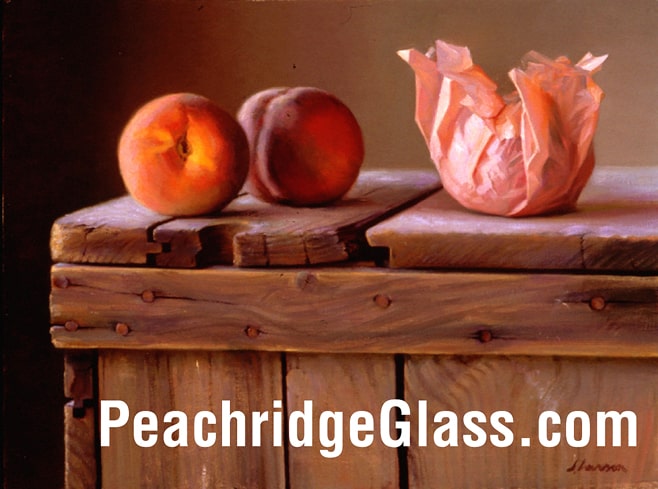 This site is presented and hosted by Ferdinand Meyer V and Elizabeth Meyer. We hope to share our passion for collecting and researching early American antique bottles and glass. Every bottle has a story. Please join the Federation of Historical Bottle Collectors.
This site is presented and hosted by Ferdinand Meyer V and Elizabeth Meyer. We hope to share our passion for collecting and researching early American antique bottles and glass. Every bottle has a story. Please join the Federation of Historical Bottle Collectors.
FOHBC Virtual Museum Still Open Free
Visit Now
January — February 2022 Issue of Bottles and Extras mails to members
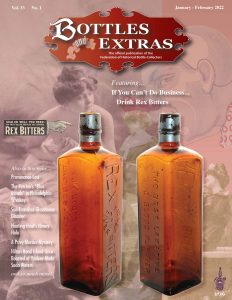 After a long run, this is the LAST issue of Bottles and Extras. The next issue will be called Antique Bottle & Glass Collector as a result of the magazine merger. To become a FOHBC member and receive Antique Bottle & Glass Collector plus a bevy of additional benefits visit FOHBC.org.
After a long run, this is the LAST issue of Bottles and Extras. The next issue will be called Antique Bottle & Glass Collector as a result of the magazine merger. To become a FOHBC member and receive Antique Bottle & Glass Collector plus a bevy of additional benefits visit FOHBC.org.
Early Georgia Sodas – the Bottles and Proprietors
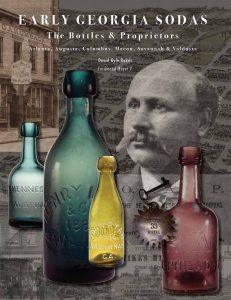 If there was such a degree as a doctorate in research, David Kyle Rakes would hold it. And, if such a degree in design existed, Ferdinand Meyer V would own it. The degrees may be mystical, but that pair has become a team and from that teamwork has evolved absolutely one of the best books sure to be treasured by collectors of Georgia’s 19th-century soda bottles. Read More
If there was such a degree as a doctorate in research, David Kyle Rakes would hold it. And, if such a degree in design existed, Ferdinand Meyer V would own it. The degrees may be mystical, but that pair has become a team and from that teamwork has evolved absolutely one of the best books sure to be treasured by collectors of Georgia’s 19th-century soda bottles. Read More
Dingen’s Napolean Cocktail Bitters Display
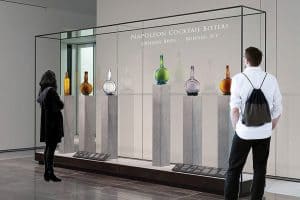 One of the most interesting and visually exciting figural bitters bottles is Napolean Cocktail Bitters put out by the Dingens Brothers in Buffalo, New York. The banjo-lady’s leg form is unique for a bitters bottle and must have had a great shelf presence wherever it was sold be it in grocery stores or taverns. Bitters were being sold as medicines even though they were full of alcohol to avoid liquor taxes. These figural bottles further distanced the product from your typical whiskey bottle and made it more “acceptable” to buy with your weekly groceries. VISIT MUSEUM
One of the most interesting and visually exciting figural bitters bottles is Napolean Cocktail Bitters put out by the Dingens Brothers in Buffalo, New York. The banjo-lady’s leg form is unique for a bitters bottle and must have had a great shelf presence wherever it was sold be it in grocery stores or taverns. Bitters were being sold as medicines even though they were full of alcohol to avoid liquor taxes. These figural bottles further distanced the product from your typical whiskey bottle and made it more “acceptable” to buy with your weekly groceries. VISIT MUSEUM
Three Great-Looking Dr. Wonser’s USA Bitters Squares
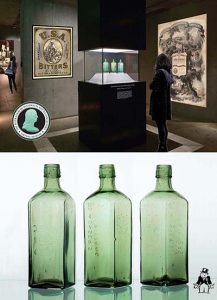 After looking at the masterful mold design for Dr. Wonser’s U.S.A. Indian Root Bitters in a cylinder form (we have three examples in our museum), we now look at a square bottle embossed ‘DR. WONSER’S BITTERS’. The bottle also is embossed ‘USA’ on a second side panel. The third and fourth sides are blank and are where the label would have gone. The square bottle came after the cylinder bottle. The bottles are found in blue and green aquamarine. All are very lightly embossed. SEE MORE
After looking at the masterful mold design for Dr. Wonser’s U.S.A. Indian Root Bitters in a cylinder form (we have three examples in our museum), we now look at a square bottle embossed ‘DR. WONSER’S BITTERS’. The bottle also is embossed ‘USA’ on a second side panel. The third and fourth sides are blank and are where the label would have gone. The square bottle came after the cylinder bottle. The bottles are found in blue and green aquamarine. All are very lightly embossed. SEE MORE
Elias Henry Van Benschoten and his Pickle Bottles
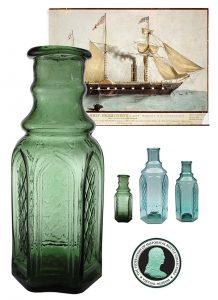 Of Dutch stock, Elias Henry Van Benschoten was born in Beekman, Dutchess Co., New York on April 28, 1814 to Henry Teunise Van Benschoten (also spelled “Van Bunschoten” or “Van Bunschooten” and Mary Jackson. Elias would marry Phoebe Kissam Underhill and they had four children, William N., Mary E., Agusta, and John N. Van Benschoten. See the bottle and read more.
Of Dutch stock, Elias Henry Van Benschoten was born in Beekman, Dutchess Co., New York on April 28, 1814 to Henry Teunise Van Benschoten (also spelled “Van Bunschoten” or “Van Bunschooten” and Mary Jackson. Elias would marry Phoebe Kissam Underhill and they had four children, William N., Mary E., Agusta, and John N. Van Benschoten. See the bottle and read more.
Hexagonal Gothic Peppersauce Bottles
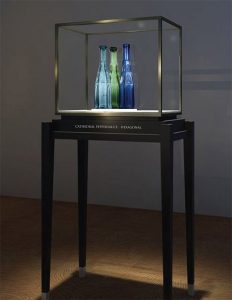 Sauces and condiments for foods were marketed as a necessity prior to the food preservation advances of the 20th century. The foods available during the 18th and 19th centuries were often bland, of dubious quality and origin and effective date-stamping did not exist. This led the way for the preparation and use of a wide variety of sauces to either enhance the food flavor or cover up any off-flavors. See and Read About
Sauces and condiments for foods were marketed as a necessity prior to the food preservation advances of the 20th century. The foods available during the 18th and 19th centuries were often bland, of dubious quality and origin and effective date-stamping did not exist. This led the way for the preparation and use of a wide variety of sauces to either enhance the food flavor or cover up any off-flavors. See and Read About
The legendary GII-57 “J.P.F. Eagle – Cornucopia “Conn” flask
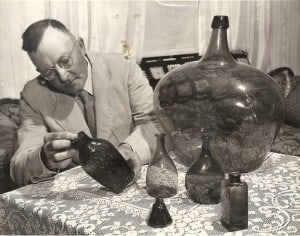 The GII-57 “J.P.F.” Eagle – Cornucopia and “Conn.” flask is a great rarity from an important Connecticut glass house. The flask is attributed to the Pitkin Glass Works from the Orford Parish of East Hartford, Connecticut. For most of its active existence, the Pitkin Glass Works was located in East Hartford until it became part of Manchester in 1823 when Manchester incorporated to become a separate town. The flask was made between 1815 and 1830. See and read all about this unique flask.
The GII-57 “J.P.F.” Eagle – Cornucopia and “Conn.” flask is a great rarity from an important Connecticut glass house. The flask is attributed to the Pitkin Glass Works from the Orford Parish of East Hartford, Connecticut. For most of its active existence, the Pitkin Glass Works was located in East Hartford until it became part of Manchester in 1823 when Manchester incorporated to become a separate town. The flask was made between 1815 and 1830. See and read all about this unique flask.
Call For Historical Information
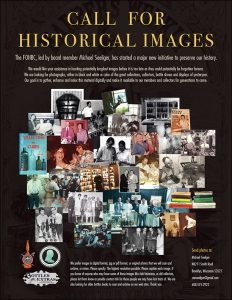 The FOHBC, led by board member Michael Seeliger, has started a major new initiative to preserve our history. We would like your assistance in locating potentially long-lost images before it is too late as they could potentially be forgotten forever. We are looking for photographs, either in black and white or color of the great collections, collectors, bottle shows and displays of yesteryear. Our goal is to gather, enhance, and index this material digitally and make it available to our members and collectors for generations to come. More Info
The FOHBC, led by board member Michael Seeliger, has started a major new initiative to preserve our history. We would like your assistance in locating potentially long-lost images before it is too late as they could potentially be forgotten forever. We are looking for photographs, either in black and white or color of the great collections, collectors, bottle shows and displays of yesteryear. Our goal is to gather, enhance, and index this material digitally and make it available to our members and collectors for generations to come. More Info
Bitters Bottles Supplement 2 Update – Available for Ordering!
 This monumental effort culminates a massive amount of work over many years. Carefully verified and cross-referenced with Bill Ham’s collected information and the Peachridge Glass database with 38,000 plus images and hundreds of files of obscure bitters. Lots of new bottles and information since 2004 when Bitters Bottle Supplement was published. Besides new and updated bottles and advertising, there are color plate sections on rare bitters, bitters facsimile bank notes, bitters postal covers, bitters almanacs, shell cards and tokens. For ephemera, the great museum-destined archives of Dan Cowman, Joe Gourd and Ben Swanson, among others, have been included. Additionally, the Index has been totally re-done to include all three books. Every documented bitters ever produced, and their makers have been indexed. This is a great tool! Thanks to Bill Ham, Joe Gourd, Ben Swanson and Jeff Burkhardt for their contributions. Research, design, and book layout by Ferdinand Meyer V. Every bottle has a story! INFO
This monumental effort culminates a massive amount of work over many years. Carefully verified and cross-referenced with Bill Ham’s collected information and the Peachridge Glass database with 38,000 plus images and hundreds of files of obscure bitters. Lots of new bottles and information since 2004 when Bitters Bottle Supplement was published. Besides new and updated bottles and advertising, there are color plate sections on rare bitters, bitters facsimile bank notes, bitters postal covers, bitters almanacs, shell cards and tokens. For ephemera, the great museum-destined archives of Dan Cowman, Joe Gourd and Ben Swanson, among others, have been included. Additionally, the Index has been totally re-done to include all three books. Every documented bitters ever produced, and their makers have been indexed. This is a great tool! Thanks to Bill Ham, Joe Gourd, Ben Swanson and Jeff Burkhardt for their contributions. Research, design, and book layout by Ferdinand Meyer V. Every bottle has a story! INFO
Pineapple Bitters
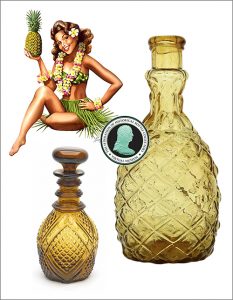 One of my favorite bottles is the Pineapple Bitters. Affluent colonists would throw dinner parties and display a pineapple as the centerpiece, projecting a symbol of their wealth, hospitality, and status. Check it out in the FOHBC Virtual Museum Bitters Gallery. Historical text updated today with a few more visuals. Remember the pineapple girl from the 2019 FOHBC Augusta National?
One of my favorite bottles is the Pineapple Bitters. Affluent colonists would throw dinner parties and display a pineapple as the centerpiece, projecting a symbol of their wealth, hospitality, and status. Check it out in the FOHBC Virtual Museum Bitters Gallery. Historical text updated today with a few more visuals. Remember the pineapple girl from the 2019 FOHBC Augusta National?
The “Tippecanoe” GVII-2 Figural Cabin
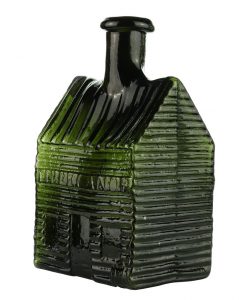 “Tippecanoe” is a nickname for William Henry Harrison from his role in the Battle of Tippecanoe. Harrison was also the ninth president of the United States from March 1841 to April 1841. “Tippecanoe” is also embossed on one of the finest pieces of early American glass ever made. William Henry Harrison was born in Charles City County, Virginia, the son of … See and read more
“Tippecanoe” is a nickname for William Henry Harrison from his role in the Battle of Tippecanoe. Harrison was also the ninth president of the United States from March 1841 to April 1841. “Tippecanoe” is also embossed on one of the finest pieces of early American glass ever made. William Henry Harrison was born in Charles City County, Virginia, the son of … See and read more
The GI-94 Franklin – Dyott historical flask
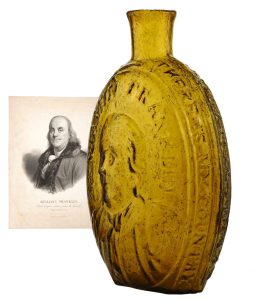 Thomas W. Dyott, the self-proclaimed “king” of American patent medicine, was a great entrepreneur who took advantage of political events and slogans from the times and interpreted them onto his pictorial flasks. This was a clever marketing ploy that netted him great profits with his customer base and audience. This astute merchandising is very evident on our GI-94 flask as Dyott capitalized on the popularity of Benjamin Franklin. See and Read More
Thomas W. Dyott, the self-proclaimed “king” of American patent medicine, was a great entrepreneur who took advantage of political events and slogans from the times and interpreted them onto his pictorial flasks. This was a clever marketing ploy that netted him great profits with his customer base and audience. This astute merchandising is very evident on our GI-94 flask as Dyott capitalized on the popularity of Benjamin Franklin. See and Read More
Two fantastic Shriver’s Baltimore Oyster Ketchup bottles added to the Virtual Museum
 Oyster bars were popular establishments starting in the early to mid-1800s and could be found in eastern cities such as Boston, New York, Philadelphia, and Baltimore that were close to the Atlantic oyster beds. The Dorlon & Shaffer Oyster House at Fulton Market in New York City was famous nationally and even internationally to travelers to the big city. The Union Oyster House in Boston is the oldest continuously open restaurant in the United States as it opened in 1826. Baltimore was the epicenter of seafood at that time with its proximity to the Chesapeake Bay. Visit the Food & Sauces Gallery and read all about it.
Oyster bars were popular establishments starting in the early to mid-1800s and could be found in eastern cities such as Boston, New York, Philadelphia, and Baltimore that were close to the Atlantic oyster beds. The Dorlon & Shaffer Oyster House at Fulton Market in New York City was famous nationally and even internationally to travelers to the big city. The Union Oyster House in Boston is the oldest continuously open restaurant in the United States as it opened in 1826. Baltimore was the epicenter of seafood at that time with its proximity to the Chesapeake Bay. Visit the Food & Sauces Gallery and read all about it.
American Life Bitters top bottle in the Glass Works Auction Premier Auction #143
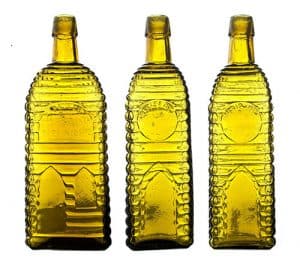 Here is a really great looking rectangular figural bitters cabin with a curved roof rather than angular like most cabin bitters. The American Life Bitters is pretty tough to obtain and there are two variants. Our museum example is extremely rare and possibly unique in color. For the most part, this bottle story is about the inventor, Peter E. Iler, who was born in Wooster, Ohio in 1840. He eventually ended up in Omaha, Nebraska. His famous bitters have either the Tiffin, Ohio, or Omaha, Nebraska embossing. READ MORE
Here is a really great looking rectangular figural bitters cabin with a curved roof rather than angular like most cabin bitters. The American Life Bitters is pretty tough to obtain and there are two variants. Our museum example is extremely rare and possibly unique in color. For the most part, this bottle story is about the inventor, Peter E. Iler, who was born in Wooster, Ohio in 1840. He eventually ended up in Omaha, Nebraska. His famous bitters have either the Tiffin, Ohio, or Omaha, Nebraska embossing. READ MORE
A spectacular two-tone amber Lacour’s Sarsapariphere Bitters
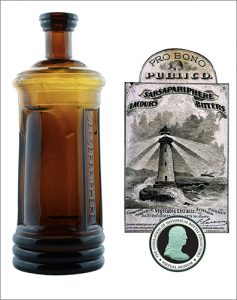 Here is a spectacular example of a two-tone amber Lacour’s Sarsapariphere Bitters from the Steven Hubbell collection. This new spinner was added to the existing page for the mint green Lacour’s Sarsapariphere Bitters. Both examples are extraordinary and will stand together in the Bitters Gallery. Alan DeMaison really did a great job imaging this bottle. Louis Lacour was born on February 26, 1821, in Saint-Fargeau, Borough of Joigny, Departement of l’Yvonne, region of Burgundy, France which is about 120 miles southeast of Paris. Lacour left Paris in 1849, and came to California, via New York, as he had heard of the California gold rush. SEE BOTTLE
Here is a spectacular example of a two-tone amber Lacour’s Sarsapariphere Bitters from the Steven Hubbell collection. This new spinner was added to the existing page for the mint green Lacour’s Sarsapariphere Bitters. Both examples are extraordinary and will stand together in the Bitters Gallery. Alan DeMaison really did a great job imaging this bottle. Louis Lacour was born on February 26, 1821, in Saint-Fargeau, Borough of Joigny, Departement of l’Yvonne, region of Burgundy, France which is about 120 miles southeast of Paris. Lacour left Paris in 1849, and came to California, via New York, as he had heard of the California gold rush. SEE BOTTLE
AT & Co. – Asher Taylor & Co.
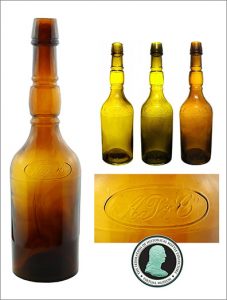 We just added a great example of the unusual AT & Co (Asher Taylor & Co.) bottle to the FOHBC Virtual Museum Bitters Gallery. A good many of the AT & Co bottles were found at the legendary 1998 dig at an old 19th-century bottle recycling plant in San Francisco, California. Twenty-five to thirty of these bottles, in various conditions, were found in great-looking shades of amber, olive amber, yellow amber, and yellow-olive. At the same dig, many other western bitters were found in subterranean caches near the AT & Co bottles. READ MORE
We just added a great example of the unusual AT & Co (Asher Taylor & Co.) bottle to the FOHBC Virtual Museum Bitters Gallery. A good many of the AT & Co bottles were found at the legendary 1998 dig at an old 19th-century bottle recycling plant in San Francisco, California. Twenty-five to thirty of these bottles, in various conditions, were found in great-looking shades of amber, olive amber, yellow amber, and yellow-olive. At the same dig, many other western bitters were found in subterranean caches near the AT & Co bottles. READ MORE
A fine Fautz’s Family Medicines – Baltimore from the Ben Swanson Collection
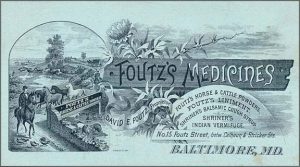 S. A. Foutz is Solomon A. Foutz. In 1857 or so, Solomon went into business with his brother David E. Foutz as S. A. Foutz & Bro. in Baltimore and manufactured and extensively sold such remedies known as “Foutz’s Horse and Cattle Powders” and “Foutz’s Liniment”. In 1867 Solomon sold out to his brother for a considerable sum of money. David E. Foutz became sole owner of all of the secret formulas, names, good will, stock of goods, and materials connected with the business. David kept the S. A. Foutz & Bro. name and until his death in 1877. Business was later conducted by his widow which evolved into a Trade-Marks and Trade Names – Unlawful Competition lawsuit. READ MORE
S. A. Foutz is Solomon A. Foutz. In 1857 or so, Solomon went into business with his brother David E. Foutz as S. A. Foutz & Bro. in Baltimore and manufactured and extensively sold such remedies known as “Foutz’s Horse and Cattle Powders” and “Foutz’s Liniment”. In 1867 Solomon sold out to his brother for a considerable sum of money. David E. Foutz became sole owner of all of the secret formulas, names, good will, stock of goods, and materials connected with the business. David kept the S. A. Foutz & Bro. name and until his death in 1877. Business was later conducted by his widow which evolved into a Trade-Marks and Trade Names – Unlawful Competition lawsuit. READ MORE
Arthur’s Patent 1855 – Arthur, Burnham & Gilroy Philadelphia
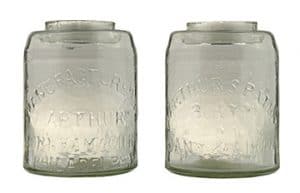 Like carved ice, an extremely rare Arthur’s Patent 1855 – Arthur, Burnham & Gilroy Philadelphia clear pint now in the FOHBC Virtual Museum Jar Gallery. Alan DeMaison did an amazing job on the piece of clear glass. The most difficult to photograph. This is the second Dr. Robert Arthur piece in the museum. Both from the 1850s. SEE THE JAR
Like carved ice, an extremely rare Arthur’s Patent 1855 – Arthur, Burnham & Gilroy Philadelphia clear pint now in the FOHBC Virtual Museum Jar Gallery. Alan DeMaison did an amazing job on the piece of clear glass. The most difficult to photograph. This is the second Dr. Robert Arthur piece in the museum. Both from the 1850s. SEE THE JAR
The Wormser Bros San Francisco figural barrel – whiskey or bitters?
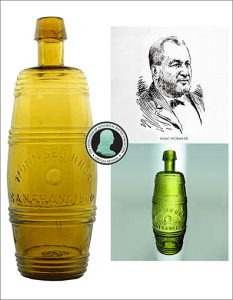 Most antique bottle collectors believe that this figural barrel-shaped bottle was a bitters product. In most cases, if a proprietor had a liquor like bourbon or whiskey, he would use a traditional long neck round bottle in quarts and fifths and use a smaller pint and half-pint flask for lesser amounts. If a proprietor had a bitters to market, he might for example use a figural barrel, cabin, or square bottle. The irony is that these products, whether it was a whiskey or bitters, contained a large amount of alcohol. It is all about marketing and who you are selling to. Unfortunately, we have no advertising to confirm this bitters assertion though it is recorded that an example with a partial label was found in Nevada. We have not seen this example. READ MORE
Most antique bottle collectors believe that this figural barrel-shaped bottle was a bitters product. In most cases, if a proprietor had a liquor like bourbon or whiskey, he would use a traditional long neck round bottle in quarts and fifths and use a smaller pint and half-pint flask for lesser amounts. If a proprietor had a bitters to market, he might for example use a figural barrel, cabin, or square bottle. The irony is that these products, whether it was a whiskey or bitters, contained a large amount of alcohol. It is all about marketing and who you are selling to. Unfortunately, we have no advertising to confirm this bitters assertion though it is recorded that an example with a partial label was found in Nevada. We have not seen this example. READ MORE
Sanded Patd Sept 25th 1877 Target Balls
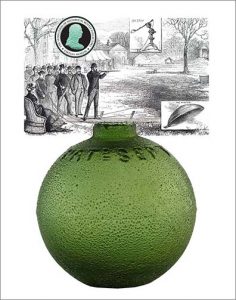 See a gorgeous deep teal, almost peacock blue target ball that is embossed PATD SEPT 25TH 1877 around the shoulder. Also a medium grass green example in a full rotation in the FOHBC Virtual Museum. These balls are 3-piece molds with an overall pebbly or sandy finish to the glass with a sheared mouth. These ‘sand balls’ are called just that because as they were cooling, they rolled the ball in very fine sand, which embedded into the glass, causing a more coarse surface. This allowed for better penetration of the ball by the shooter. The ball is 2 5/8″ in diameter and perfect. SEE THE TARGET BALLS
See a gorgeous deep teal, almost peacock blue target ball that is embossed PATD SEPT 25TH 1877 around the shoulder. Also a medium grass green example in a full rotation in the FOHBC Virtual Museum. These balls are 3-piece molds with an overall pebbly or sandy finish to the glass with a sheared mouth. These ‘sand balls’ are called just that because as they were cooling, they rolled the ball in very fine sand, which embedded into the glass, causing a more coarse surface. This allowed for better penetration of the ball by the shooter. The ball is 2 5/8″ in diameter and perfect. SEE THE TARGET BALLS
A. Stone & Co. Cunninghams & Co. Philadelphia in olive green
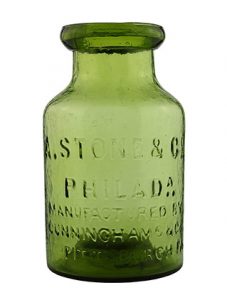 This is the earliest Stone Jar. Our quart A. Stone & Co. groove ring wax sealer jar in this beautiful olive green glass color is unique. The jar has a high kick-up, bare iron pontil scar. These rare jars are usually found in aqua and can also be found in half-gallons.
This is the earliest Stone Jar. Our quart A. Stone & Co. groove ring wax sealer jar in this beautiful olive green glass color is unique. The jar has a high kick-up, bare iron pontil scar. These rare jars are usually found in aqua and can also be found in half-gallons.
Two California Wine Bitters now spinning in the FOHBC Virtual Museum
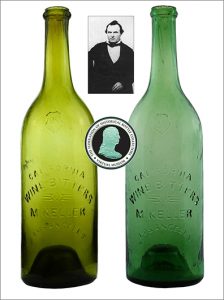 California Wine Bitters is an extremely desirable, top-25 western bitters that is considered very rare. The round cylinder bottles are typically found in beautiful shades of green. A western collector once noted that of the ten or so examples he had either owned, handled, or seen, each was a different green color. Of the specimens that are known, the bottles have been found in the eastern and western United States. It was reported that a whole example was found at a mining camp near Desert Hills, Arizona, 35 miles from Apache Junction and one example came from an early river town in the Northern Sacramento Valley. Broken examples have been found in San Francisco and a few examples have even been found under buildings in New Hampshire. SEE EXAMPLES
California Wine Bitters is an extremely desirable, top-25 western bitters that is considered very rare. The round cylinder bottles are typically found in beautiful shades of green. A western collector once noted that of the ten or so examples he had either owned, handled, or seen, each was a different green color. Of the specimens that are known, the bottles have been found in the eastern and western United States. It was reported that a whole example was found at a mining camp near Desert Hills, Arizona, 35 miles from Apache Junction and one example came from an early river town in the Northern Sacramento Valley. Broken examples have been found in San Francisco and a few examples have even been found under buildings in New Hampshire. SEE EXAMPLES
A. Stone & Co. Philada. wax sealer In aquamarine
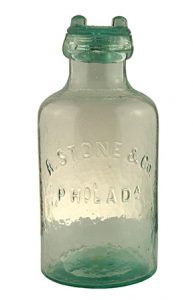 This early, small-mouth, quart wax sealer jar is embossed A. STONE & Co. in an arch on the face of the container. The ‘O’ in ‘Co.’ is smaller. Centered beneath, in a horizontal line, is PHILADA. The last ‘A’ is smaller. This same information is typically embossed on the glass stopper. The unusual narrow mouth glass stopper is typically found on their pint jars. The bottoms are usually unmarked and smooth.
This early, small-mouth, quart wax sealer jar is embossed A. STONE & Co. in an arch on the face of the container. The ‘O’ in ‘Co.’ is smaller. Centered beneath, in a horizontal line, is PHILADA. The last ‘A’ is smaller. This same information is typically embossed on the glass stopper. The unusual narrow mouth glass stopper is typically found on their pint jars. The bottoms are usually unmarked and smooth.
“All must surrender to Constitution Bitters”
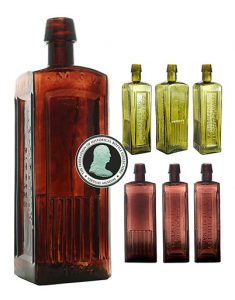 Here is an extraordinary rectangular Constitution Bitters in a medium pink amethyst or puce glass coloration. These bottles are typically found in shades of amber. This Constitution Bitters brand (there is another figural bottle with the same name), we are dealing with Stephen B. Seward and Burr S. Bentley of Seward & Bentley in Buffalo, New York. There are also listings for Seward, Bentley & Cheney, Ward & Bentley, and Daniel Seward & Co., that show obvious changes in partnership and ownership later in the 1860s. Stephen Seward even got his start earlier than that as his name occurs as S. B. Seward in the late 1850s on bottles and advertising etc. When this bottle mold was produced, Cheney had not yet joined the firm. READ & SEE MORE
Here is an extraordinary rectangular Constitution Bitters in a medium pink amethyst or puce glass coloration. These bottles are typically found in shades of amber. This Constitution Bitters brand (there is another figural bottle with the same name), we are dealing with Stephen B. Seward and Burr S. Bentley of Seward & Bentley in Buffalo, New York. There are also listings for Seward, Bentley & Cheney, Ward & Bentley, and Daniel Seward & Co., that show obvious changes in partnership and ownership later in the 1860s. Stephen Seward even got his start earlier than that as his name occurs as S. B. Seward in the late 1850s on bottles and advertising etc. When this bottle mold was produced, Cheney had not yet joined the firm. READ & SEE MORE
An Unusual Dark Teal Green Jar
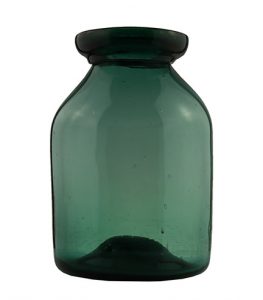 Free-blown means glass-forming by blowing and manipulating by hand and tools without the aid of a mold to shape the bottle. A free-blown bottle has no mold seams or other mold-induced markings. Our museum example represents a type of jar produced in the Pittsburgh District which typically comprises Louisville, Cincinnati, and Pittsburgh geographic…
Free-blown means glass-forming by blowing and manipulating by hand and tools without the aid of a mold to shape the bottle. A free-blown bottle has no mold seams or other mold-induced markings. Our museum example represents a type of jar produced in the Pittsburgh District which typically comprises Louisville, Cincinnati, and Pittsburgh geographic…
Dorlon & Shaffer Pickled Oysters
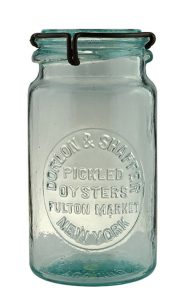 Back on the saddle so to speak. The FOHBC Virtual Museum site had more issues that started last Friday morning that prevented me from posting. Actually, four (4) web sites that I oversee went down during this period. FMG Design, Peachridge Glass, FOHBC, and the FOHBC Virtual Museum. Been a challenge, working with Miguel Ruiz to get back up in an environment where service has dropped or been prolonged due to the Coronavirus. I think layoffs are involved too. Anyway, here is a wonderful Dorlon & Shaffer Pickled Oysters jar with a story that I started last week and just completed. Would make a good story in Bottles and Extras.
Back on the saddle so to speak. The FOHBC Virtual Museum site had more issues that started last Friday morning that prevented me from posting. Actually, four (4) web sites that I oversee went down during this period. FMG Design, Peachridge Glass, FOHBC, and the FOHBC Virtual Museum. Been a challenge, working with Miguel Ruiz to get back up in an environment where service has dropped or been prolonged due to the Coronavirus. I think layoffs are involved too. Anyway, here is a wonderful Dorlon & Shaffer Pickled Oysters jar with a story that I started last week and just completed. Would make a good story in Bottles and Extras.
2019 FOHBC 50th Anniversary National Antique Bottle Convention | Augusta, Georgia | Souvenir Program
Well, the show is over and we are catching our breath. A couple of years of work boiling down to three or four intense days in Augusta. Now as the dust settles, we settle our accounts, collects some comments, look thru a couple thousand images and prepare for write-ups in Bottles and Extras and Antique Bottle & Glass Collector. A special shout-out to advertisers in our Souvenir Program. An important source of revenue and information.
[Read]



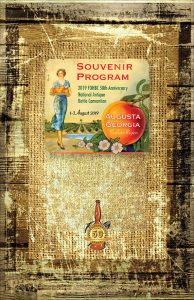
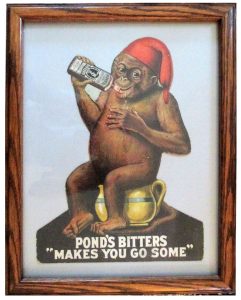
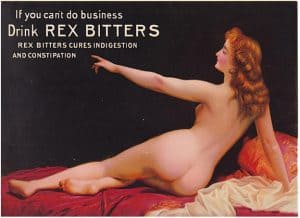
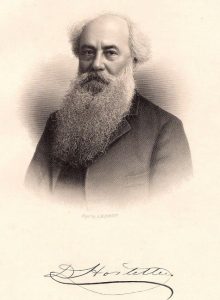
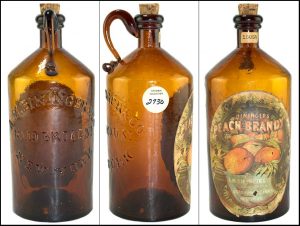
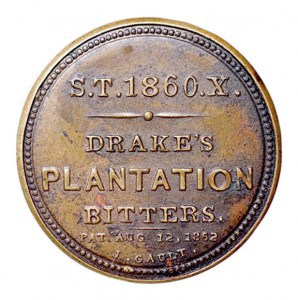








I’ve just spent several hours perusing this website for Antique Bottle Collectors, I have to say this is the most comprehensive internet site ever developed for the antique bottle enthusiast. It is destined to be the GO TO site for all those interested in the antique bottle hobby.
This is a great looking website — well done! Love all the pix of the beautiful bottles. Looking forward to watching this site grow. All the best wishes from the Findlay Bottle Club! –Marianne Dow
Well done, Ferd. Lots of great info and destined to be a favorite of a bunch of collectors.
Great job Ferd ! The information and enjoyment of your site is a huge asset to the bottle and glass collecting community not to mention the history buff ! My enjoyment of collecting has just increased 10 fold thanks to your efforts !